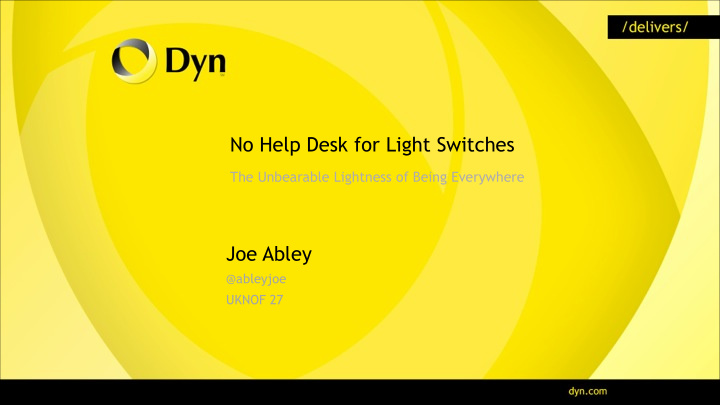



No Help Desk for Light Switches The Unbearable Lightness of Being Everywhere Joe Abley @ableyjoe UKNOF 27 Pg.
Technical Awareness of End Users in Decline Let us rejoice together in our collective lack of surprise • a consequence of the continued mainstreaming of the Internet as a conduit for all things • refrigerators, thermostats, door locks, alarms • news, dictionaries, travel, television, phone, mail, everything • most end-users of bathrooms don't understand plumbing, either
Who do your customers call? • if a service is broken, call the service operator (maybe) • if a device is broken, call the shop (maybe) • if the network is broken, call you (maybe) • get your teenage child to look at it • if none of those things work, you're stuck • stop using whatever it is • oh noes
Outsourced Reliability • if you're an established outfit with revenue, you can build massive infrastructure • expensive, difficult • if you're a tiny startup perhaps you can't afford the cost of a huge build-out, which is a shame because your idea depends on reliability, more so than the big guys even • rise of the data centre, rise of the cloud • compute, storage, operations, ... and DNS
Wide-Scale Distribution of DNS Service • People have been using anycast to distribute DNS service for a long time • authoritative DNS service, recursive service • protocol is (often, usually) stateless • transactions are (often, usually) short-lived • largely unaffected by routing churn • probably, apparently
How much Anycast is Enough? F: 56 I: 43 J: 74 K: 17 L: 146
How many ASes are there?
Aim to Scale • If we're going to build out DNS service on a grand scale, we might as well aim big • "at least one node per AS" • Keep attack flows on-net • Minimise the RTT • Reduce the hardware requirements of an individual node to something that can be built for $1,000 and treated as a network appliance
Operational Implications • If we don't want to have to hire thousands more people, we need all these nodes to be heavily automated • self-service for network operators (renumbering, BGP session maintenance, etc) • ship direct from factory to site • installation and troubleshooting simplified to a level that would not challenge a small child • low-power appliance, suitable for mounting in a two-post rack (no shelves, no rails)
Security Considerations • Every node (from our perspective) is installed in a hostile, remote network • Starting point is to assume that Bad People are going to compromise the box immediately, if not sooner • no secrets on any node beyond those associated with the node itself • regular, frequent, automatic bare-metal reinstallation (like Crashmonkey... Reinstallmonkey?) • careful thinking required
Operational Management • Patch and configuration management (plus associated test processes) completely automated • chef • Element monitoring (centralised and distributed) provisioned along with each node, so the list of things to ping, etc is always complete and up-to-date • careful thinking for escalation, to avoid the situation where a single problem causes 50,000 alarms per second, and the NOC shoot themselves
Data Flow • Many of these nodes will be in dark, cobwebby, poorly- connected parts of the Internet • need to be light on the network, and extremely tolerant of congestion and isolation • opportunistic peer-to-peer model whereby the swarm of nodes can exchange provisioning data, zone data and measurement summaries with each other • We do not expect full centralisation of data to be possible, so we need to be able to distribute analysis to the edge
Add it together and what do we get? • Massively-redundant, massively-distributed DNS service • more reliable, faster, very shiny • ridiculously scaleable • A new level of service intelligence • as many views of the global routing table as we have nodes • an additional dimension for assessing client reputation, significantly less prone to error from external topology changes
Why should any ISP care? • That's why I'm here. We want you to care. Tell us why you might care. • routing intelligence? • real-time feeds of information about your customers? • long-term trends in DNS use • indications of customer infections • faster, more reliable DNS service for services that your customers want to be up?
Why should any ISP care? • recursive service for use by your customers? • ability to monitor your own infrastructure from many places outside your network? • DNS services (registration, hosting)? � � • something else?
Recommend
More recommend